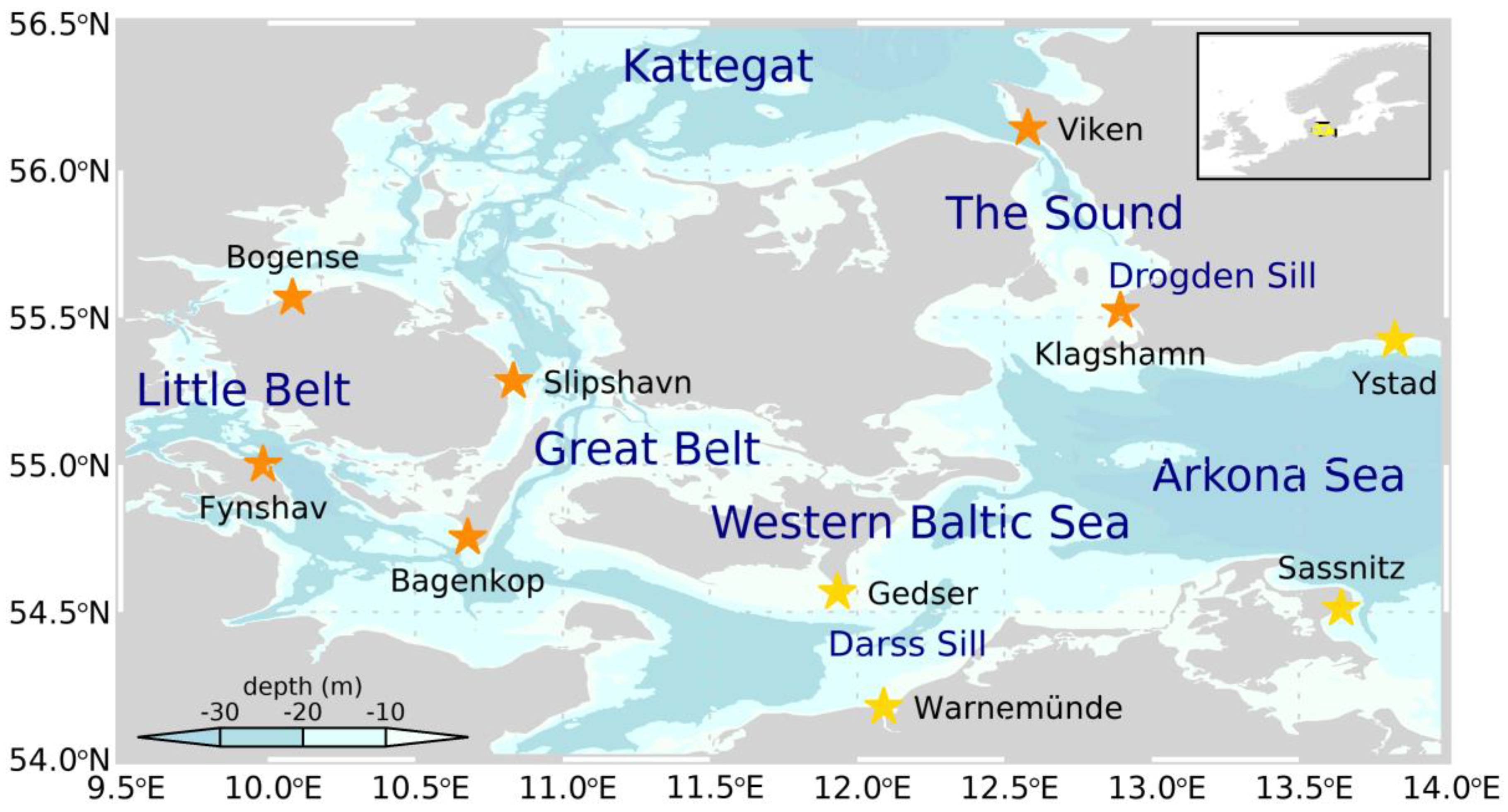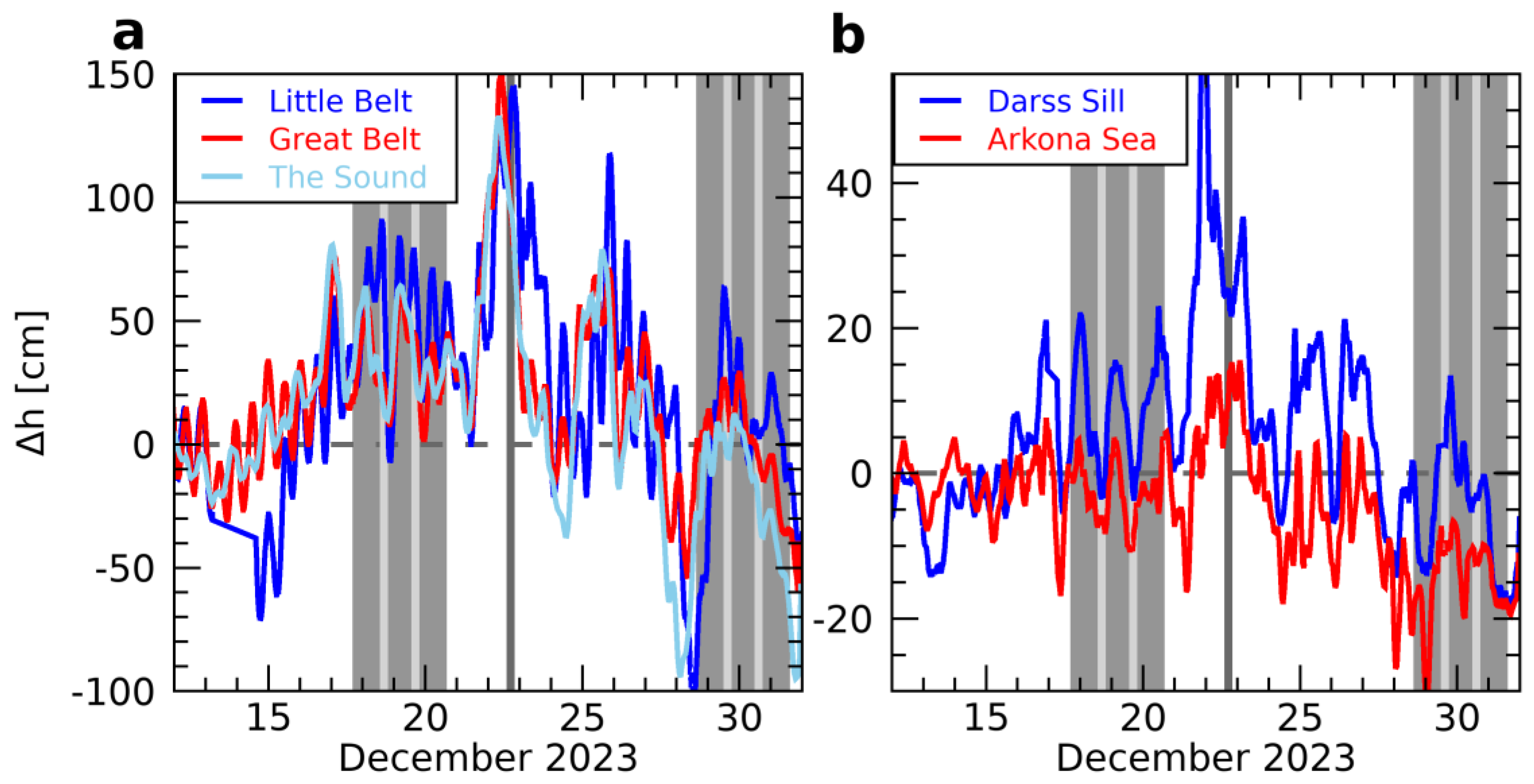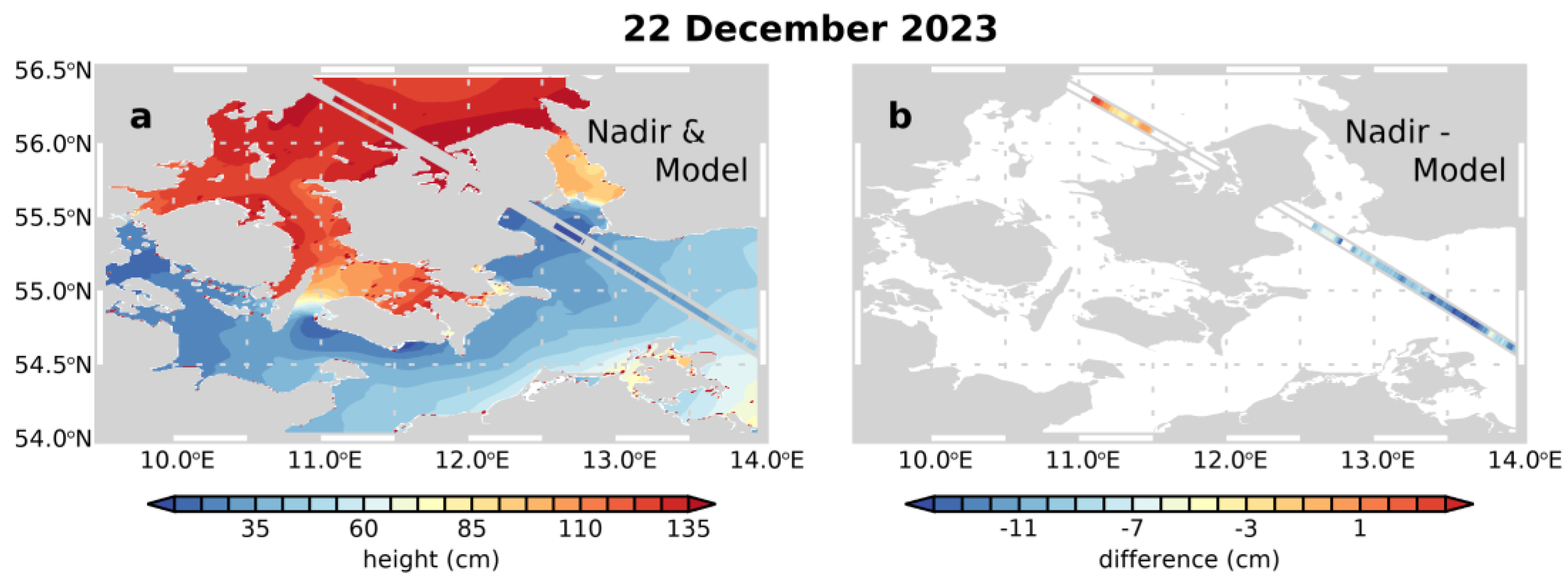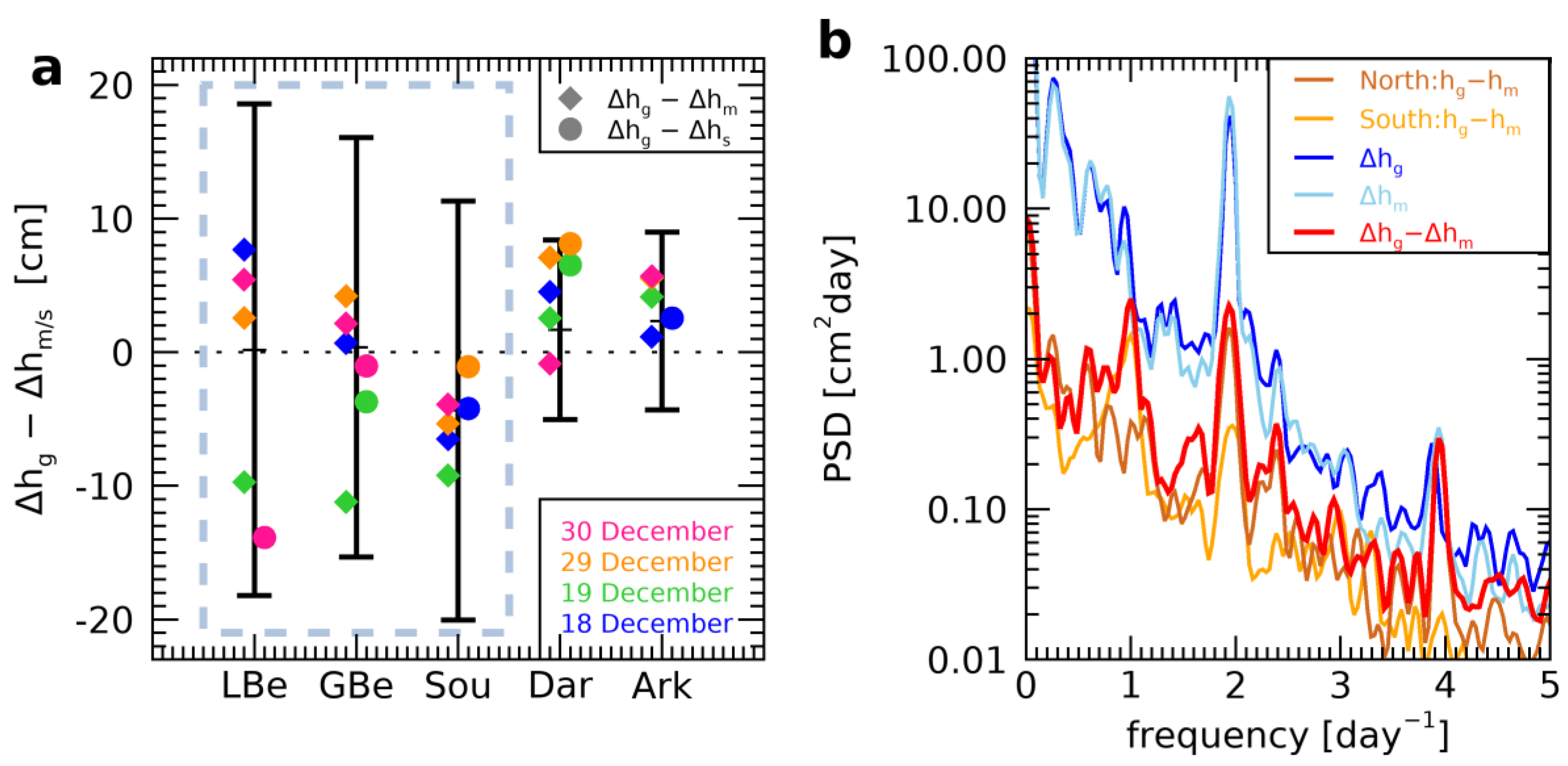The 2023 Major Baltic Inflow Event Observed by Surface Water and Ocean Topography (SWOT) and Nadir Altimetry
Abstract
1. Introduction
2. Data and Processing
2.1. SWOT Observations
2.2. Nadir Altimetry
| Correction | Model |
|---|---|
| orbit | CNES-SSALTO, POE-F |
| ionosphere | GIM model [24] |
| wet troposphere | ECMWF model (GDR internal) |
| dry troposphere | ECMWF model (GDR internal) |
| Earth tide | IERS [25] |
| pole tide | Desai [26] |
| ocean loading tide | FES 2014b [27] |
| sea state bias | GDR internal |
| vertical reference (SLi) | CLS_CNES 2022 (MSS and MDT) [28,29] |
| ocean tide (SLA) | FES 2014b [27] |
| DAC (SLA) | MOG2D-G [30] |
| vertical reference (SLA) | CLS_CNES 2022 (MSS) [28] |
2.3. Tide Gauges
2.4. BSH-HBMnoku Model
2.5. Relative Explained Variance of the Observations by BSH-HBMnoku
3. Results
3.1. Sea-Level Signatures of the Major Baltic Inflow Event
3.2. Comparison of SWOT to Nadir Altimetry Data
4. Discussion
5. Conclusions
Author Contributions
Funding
Data Availability Statement
Acknowledgments
Conflicts of Interest
Abbreviations
| GDR | Geophysical Data Record |
| HBM | High-Resolution Model for the Baltic Sea—Baltic Operational Oceanography System |
| KaRIn | Ka-band Radar Interferometer |
| MBI | Major Baltic Inflow |
| REV | Relative Explained Variance |
| SAR | Synthetic Aperture Radar |
| SLA | Sea Level Anomaly |
| SLi | Instantaneous Sea Level |
| SWOT | Surface Water and Ocean Topography Mission |
References
- Weisse, R.; Dailidiene, I.; Hünicke, B.; Kahma, K.; Madsen, K.; Omstedt, A.; Parnell, K.; Schöne, T.; Soomere, T.; Zhang, W.; et al. Sea Level Dynamics and Coastal Erosion in the Baltic Sea Region. Earth Syst. Dyn. 2021, 12, 871–898. [Google Scholar] [CrossRef]
- Lehmann, A.; Myrberg, K.; Post, P.; Chubarenko, I.; Dailidiene, I.; Hinrichsen, H.-H.; Hüssy, K.; Liblik, T.; Meier, H.E.M.; Lips, U.; et al. Salinity Dynamics of the Baltic Sea. Earth Syst. Dyn. 2022, 13, 373–392. [Google Scholar] [CrossRef]
- Lass, H.U.; Matthäus, W. On Temporal Wind Variations Forcing Salt Water Inflows into the Baltic Sea. Tellus A Dyn. Meteorol. Oceanogr. 1996, 48, 663–671. [Google Scholar] [CrossRef]
- Mohrholz, V. Major Baltic Inflow Statistics–Revised. Front. Mar. Sci. 2018, 5, 384. [Google Scholar] [CrossRef]
- Mohrholz, V.; Naumann, M.; Nausch, G.; Krüger, S.; Gräwe, U. Fresh Oxygen for the Baltic Sea—An Exceptional Saline Inflow after a Decade of Stagnation. J. Mar. Syst. 2015, 148, 152–166. [Google Scholar] [CrossRef]
- Stanev, E.V.; Pein, J.; Grashorn, S.; Zhang, Y.; Schrum, C. Dynamics of the Baltic Sea Straits via Numerical Simulation of Exchange Flows. Ocean Model. 2018, 131, 40–58. [Google Scholar] [CrossRef]
- Purkiani, K.; Jochumsen, K.; Fischer, J.-G. Observation of a Moderate Major Baltic Sea Inflow in December 2023. Sci. Rep. 2024, 14, 16577. [Google Scholar] [CrossRef]
- Pham, N.T.; Staneva, J.; Bonaduce, A.; Stanev, E.V.; Grayek, S. Interannual Sea Level Variability in the North and Baltic Seas and Net Flux through the Danish Straits. Ocean Dyn. 2024, 74, 669–684. [Google Scholar] [CrossRef]
- Brüning, T.; Li, X.; Schwichtenberg, F.; Lorkowski, I. An Operational, Assimilative Model System for Hydrodynamic and Biogeochemical Applications for German Coastal Waters. Hydrogr. Nachrichten 2021, 118, 6–15. [Google Scholar] [CrossRef]
- Abdalla, S.; Kolahchi, A.A.; Adusumilli, S.; Bhowmick, S.A.; Alou-Font, E.; Amarouche, L.; Andersen, O.B.; Antich, H.; Aouf, L.; Arbic, B.; et al. Altimetry for the Future: Building on 25 Years of Progress. Adv. Space Res. 2021, 68, 319–363. [Google Scholar] [CrossRef]
- Cipollini, P.; Calafat, F.M.; Jevrejeva, S.; Melet, A.; Prandi, P. Monitoring Sea Level in the Coastal Zone with Satellite Altimetry and Tide Gauges. Surv. Geophys. 2017, 38, 33–57. [Google Scholar] [CrossRef] [PubMed]
- Vignudelli, S.; Birol, F.; Benveniste, J.; Fu, L.-L.; Picot, N.; Raynal, M.; Roinard, H. Satellite Altimetry Measurements of Sea Level in the Coastal Zone. Surv. Geophys. 2019, 40, 1319–1349. [Google Scholar] [CrossRef]
- Esselborn, S.; Schöne, T.; Illigner, J.; Weiß, R.; Artz, T.; Huang, X. Validation of Recent Altimeter Missions at Non-Dedicated Tide Gauge Stations in the Southeastern North Sea. Remote Sens. 2022, 14, 236. [Google Scholar] [CrossRef]
- Pujol, M.-I.; Dupuy, S.; Vergara, O.; Román, A.S.; Faugère, Y.; Prandi, P.; Dabat, M.-L.; Dagneaux, Q.; Lievin, M.; Cadier, E.; et al. Refining the Resolution of DUACS Along-Track Level-3 Sea Level Altimetry Products. Remote Sens. 2023, 15, 793. [Google Scholar] [CrossRef]
- Metzner, M.; Gade, M.; Hennings, I.; Rabinovich, A.B. The Observation of Seiches in the Baltic Sea Using a Multi Data Set of Water Levels. J. Mar. Syst. 2000, 24, 67–84. [Google Scholar] [CrossRef]
- Liebsch, G.; Novotny, K.; Dietrich, R.; Shum, C.K. Comparison of Multimission Altimetric Sea-Surface Heights with Tide Gauge Observations in the Southern Baltic Sea. Mar. Geod. 2002, 25, 213–234. [Google Scholar] [CrossRef]
- Madsen, K.S.; Høyer, J.L.; Tscherning, C.C. Near-Coastal Satellite Altimetry: Sea Surface Height Variability in the North Sea–Baltic Sea Area. Geophys. Res. Lett. 2007, 34, L14601. [Google Scholar] [CrossRef]
- Madsen, K.S.; Høyer, J.L.; Suursaar, Ü.; She, J.; Knudsen, P. Sea Level Trends and Variability of the Baltic Sea From 2D Statistical Reconstruction and Altimetry. Front. Earth Sci. 2019, 7, 243. [Google Scholar] [CrossRef]
- Passaro, M.; Müller, F.L.; Oelsmann, J.; Rautiainen, L.; Dettmering, D.; Hart-Davis, M.G.; Abulaitijiang, A.; Andersen, O.B.; Høyer, J.L.; Madsen, K.S.; et al. Absolute Baltic Sea Level Trends in the Satellite Altimetry Era: A Revisit. Front. Mar. Sci. 2021, 8, 647607. [Google Scholar] [CrossRef]
- Elken, J.; Barzandeh, A.; Maljutenko, I.; Rikka, S. Reconstruction of Baltic Gridded Sea Levels from Tide Gauge and Altimetry Observations Using Spatiotemporal Statistics from Reanalysis. Remote Sens. 2024, 16, 2702. [Google Scholar] [CrossRef]
- Fu, L.-L.; Pavelsky, T.; Cretaux, J.-F.; Morrow, R.; Farrar, J.T.; Vaze, P.; Sengenes, P.; Vinogradova-Shiffer, N.; Sylvestre-Baron, A.; Picot, N.; et al. The Surface Water and Ocean Topography Mission: A Breakthrough in Radar Remote Sensing of the Ocean and Land Surface Water. Geophys. Res. Lett. 2024, 51, e2023GL107652. [Google Scholar] [CrossRef]
- SWOT Project, SWOT Level-2 KaRIn Low Rate SSH Expert (v2.0), 2024, CNES. Available online: https://www.aviso.altimetry.fr/en/data/products/sea-surface-height-products/global/swot-karin-low-rate-ocean-products.html (accessed on 1 December 2024).
- Schöne, T.; Esselborn, S.; Rudenko, S.; Raimondo, J.-C. Radar Altimetry Derived Sea Level Anomalies—The Benefit of New Orbits and Harmonization. In System Earth via Geodetic-Geophysical Space Techniques; Flechtner, F.M., Gruber, T., Güntner, A., Mandea, M., Rothacher, M., Schöne, T., Wickert, J., Eds.; Springer: Berlin/Heidelberg, Germany, 2010; pp. 317–324. ISBN 978-3-642-10227-1. [Google Scholar]
- Dach, R.; Schaer, S.; Arnold, D.; Kalarus, M.S.; Prange, L.; Stebler, P.; Villiger, A.; Jäggi, A. CODE Final Product Series for the IGS. In Dach Rolf Schaer Stefan Arnold Daniel Kalarus Maciej Sebastian Prange Lars Stebler Pascal Villiger Arturo Jäggi Adrian 2020 CODE Final Prod. Ser. IGS Datensatz Astron; The University of Bern: Bern, Switzerland, 2020. [Google Scholar]
- Petit, G.; Luzum, B. IERS Conventions (2010); IERS Technical Note; Verlag des Bundesamts für Kartographie und Geodäsie: Frankfurt am Main, Germany, 2010; p. 179. ISBN 3-89888-989-6. [Google Scholar]
- Desai, S.; Wahr, J.; Beckley, B. Revisiting the Pole Tide for and from Satellite Altimetry. J. Geod. 2015, 89, 1233–1243. [Google Scholar] [CrossRef]
- Lyard, F.H.; Allain, D.J.; Cancet, M.; Carrère, L.; Picot, N. FES2014 Global Ocean Tide Atlas: Design and Performance. Ocean Sci. 2021, 17, 615–649. [Google Scholar] [CrossRef]
- Schaeffer, P.; Pujol, M.-I.; Veillard, P.; Faugere, Y.; Dagneaux, Q.; Dibarboure, G.; Picot, N. The CNES CLS 2022 Mean Sea Surface: Short Wavelength Improvements from CryoSat-2 and SARAL/AltiKa High-Sampled Altimeter Data. Remote Sens. 2023, 15, 2910. [Google Scholar] [CrossRef]
- Jousset, S.; Mulet, S.; Greiner, E.; Wilkin, J.; Vidar, L.; Dibarboure, G.; Picot, N. New Global Mean Dynamic Topography CNES-CLS-22 Combining Drifters, Hydrological Profiles and High Frequency Radar Data. ESS Open Arch. 2023, preprint. [Google Scholar] [CrossRef]
- Carrère, L.; Lyard, F. Modeling the Barotropic Response of the Global Ocean to Atmospheric Wind and Pressure Forcing-Comparisons with Observations. Geophys. Res. Lett. 2003, 30, 1275. [Google Scholar] [CrossRef]
- Omstedt, A.; Elken, J.; Lehmann, A.; Leppäranta, M.; Meier, H.E.M.; Myrberg, K.; Rutgersson, A. Progress in Physical Oceanography of the Baltic Sea during the 2003–2014 Period. Prog. Oceanogr. 2014, 128, 139–171. [Google Scholar] [CrossRef]
- Le Traon, P.Y.; Reppucci, A.; Alvarez Fanjul, E.; Aouf, L.; Behrens, A.; Belmonte, M.; Bentamy, A.; Bertino, L.; Brando, V.E.; Kreiner, M.B.; et al. From Observation to Information and Users: The Copernicus Marine Service Perspective. Front. Mar. Sci. 2019, 6, 234. [Google Scholar] [CrossRef]
- Schwabe, J.; Ågren, J.; Liebsch, G.; Westfeld, P.; Hammarklint, T.; Mononen, J.; Andersen, O.B. The Baltic Sea Chart Datum 2000 (BSCD2000): Implementation of a Common Reference Level in the Baltic Sea. Int. Hydrogr. Rev. 2020, 23, 63–82. [Google Scholar]
- Mitchum, G.T. Comparison of TOPEX Sea Surface Heights and Tide Gauge Sea Levels. J. Geophys. Res. Oceans 1994, 99, 24541–24553. [Google Scholar] [CrossRef]
- Fenoglio-Marc, L.; Schöne, T.; Illigner, J.; Becker, M.; Manurung, P. Khafid Sea Level Change and Vertical Motion from Satellite Altimetry, Tide Gauges and GPS in the Indonesian Region. Mar. Geod. 2012, 35, 137–150. [Google Scholar] [CrossRef]
- Männel, B.; Schöne, T.; Bradke, M.; Schuh, H. Vertical Land Motion at Tide Gauges Observed by GNSS: A New GFZ-TIGA Solution. In Geodesy for a Sustainable Earth: Proceedings of the 2021 Scientific Assembly of the International Association of Geodesy, Beijing, China, 28 June–2 July 2021; Freymueller, J.T., Sánchez, L., Eds.; Springer International Publishing: Cham, Switzerland, 2023; pp. 279–287. [Google Scholar] [CrossRef]
- Lorenz, M.; Viigand, K.; Gräwe, U. Untangling the Waves: Decomposing Extreme Sea Levels in a Non-Tidal Basin, the Baltic Sea. Nat. Hazards Earth Syst. Sci. 2024; preprint. [Google Scholar] [CrossRef]
- Jönsson, B.; Döös, K.; Nycander, J.; Lundberg, P. Standing Waves in the Gulf of Finland and Their Relationship to the Basin-Wide Baltic Seiches. J. Geophys. Res. Oceans 2008, 113, C03004. [Google Scholar] [CrossRef]
- Stramska, M.; Aniskiewicz, P. Satellite Remote Sensing Signatures of the Major Baltic Inflows. Remote Sens. 2019, 11, 954. [Google Scholar] [CrossRef]
- Elyouncha, A.; Broström, G.; Johnsen, H. Synergistic Utilization of Spaceborne SAR Observations for Monitoring the Baltic Sea Flow Through the Danish Straits. Earth Space Sci. 2024, 11, e2024EA003794. [Google Scholar] [CrossRef]







| Little Belt | Great Belt | The Sound | Darss Sill | Arkona Sea |
|---|---|---|---|---|
| Bogense | Slipshavn | Viken | Gedser | Ystad |
| Fynshav | Bagenkop | Klagshamn | Warnemünde | Sassnitz |
Disclaimer/Publisher’s Note: The statements, opinions and data contained in all publications are solely those of the individual author(s) and contributor(s) and not of MDPI and/or the editor(s). MDPI and/or the editor(s) disclaim responsibility for any injury to people or property resulting from any ideas, methods, instructions or products referred to in the content. |
© 2025 by the authors. Licensee MDPI, Basel, Switzerland. This article is an open access article distributed under the terms and conditions of the Creative Commons Attribution (CC BY) license (https://creativecommons.org/licenses/by/4.0/).
Share and Cite
Esselborn, S.; Schöne, T.; Dobslaw, H.; Sulzbach, R. The 2023 Major Baltic Inflow Event Observed by Surface Water and Ocean Topography (SWOT) and Nadir Altimetry. Remote Sens. 2025, 17, 1289. https://doi.org/10.3390/rs17071289
Esselborn S, Schöne T, Dobslaw H, Sulzbach R. The 2023 Major Baltic Inflow Event Observed by Surface Water and Ocean Topography (SWOT) and Nadir Altimetry. Remote Sensing. 2025; 17(7):1289. https://doi.org/10.3390/rs17071289
Chicago/Turabian StyleEsselborn, Saskia, Tilo Schöne, Henryk Dobslaw, and Roman Sulzbach. 2025. "The 2023 Major Baltic Inflow Event Observed by Surface Water and Ocean Topography (SWOT) and Nadir Altimetry" Remote Sensing 17, no. 7: 1289. https://doi.org/10.3390/rs17071289
APA StyleEsselborn, S., Schöne, T., Dobslaw, H., & Sulzbach, R. (2025). The 2023 Major Baltic Inflow Event Observed by Surface Water and Ocean Topography (SWOT) and Nadir Altimetry. Remote Sensing, 17(7), 1289. https://doi.org/10.3390/rs17071289







